Abstract
Although walking methodologies (WMs) and machine learning (ML) have been objects of interest for urban scholars, it is difficult to find research that integrates both. We propose a ‘cyborg walk’ method and apply it to studying litter in public spaces. Walking routes are created based on an unsupervised learning algorithm (k-means) to classify public spaces. Then, a deep learning model (YOLOv5) is used to collect data from geotagged photos taken by an automatic Insta360 X3 camera worn by human walkers. Results from image recognition have an accuracy between 83.7% and 95%, which is similar to what is validated by the literature. The data collected by the machine are automatically georeferenced thanks to the metadata generated by a GPS attached to the camera. WMs could benefit from the introduction of ML for informative route optimisation and georeferenced visual data quantification. The links between these findings and the existing WM literature are discussed, reflecting on the parallels between this ‘cyborg walk’ experiment and the seminal cyborg metaphor proposed by Donna Haraway.
1. Introduction
Mobile methodologies are becoming increasingly relevant for research on urban life. Consequently, walking is situated at the centre of reflections on public spaces [1]. Within urban studies, walking methodologies (WMs) stand out as a strongly legitimate way to reveal the city in its different dimensions [1,2,3,4,5,6]. Walking is used by many disciplines as an ethnographic method of observation based on the researcher’s experiences, since it implies the ‘direct observation of the material aspects—verbal, gestural, sound and corporal—of human activity, that is, of the rituality of which the daily life of societies is composed’ [7]. Cognition, perceptions and senses play a fundamental role in the process of collecting information while walking [8]. Moreover, walking is increasingly used to conduct research on non-human phenomena, such as technology, buildings and geological elements [9,10,11].
WMs have been applied in diverse forms and fields, most frequently within the social sciences, the humanities, education and the arts (see Section 2.1 for a comprehensive taxonomy). Yet, most of the studies applying WMs tend to remain strongly qualitative, without any integration of quantitative methods, and very few integrate the most recent technologies, such as ML. Some of the scarce incorporations of new technologies into WMs involve digital photography, the global positioning system (GPS) [12,13], digital social media, platforms, apps [14], renders and virtual reality [15].
In parallel to the continuous adoption of WMs (see [16] for a recent example), urban scholars are also introducing machine learning (ML) into their research [17]. Yet, we were not able to find any integration of ML into WMs. This could be limiting the potential of WMs, as other fields are using ML to solve issues such as routing and visual examination, both of which are relevant functions within WMs (see Section 2.2 and Section 2.3). Trying to bridge this gap, the present research focuses on the transdisciplinary potential of the combination of WMs and ML in exploring urban space. We name such a potential mixture as ‘cyborg walking’ (CW), using the cyborg concept while acknowledging its critical ascendance within the humanities and social sciences [18] but also its widespread pragmatic adoption in fields such as robotics [19], computer security [20], nanoelectronics [21] and medicine [22].
In what follows, we first provide a review of both the existing WMs and the specific problem of route definition, discussing machine- and human-based routing methodologies. We were able to distinguish 16 types of WMs, and to highlight the advances in informative route optimisation from fields such as robotics, unmanned aerial vehicles and viticulture, which could be introduced into WMs by using ML. Second, we generate an experiment to assess the potential of ML in both defining informative routes and providing quantitative georeferenced data during human walks. We are able to test a method based on ML to explore incivilities in public spaces, including an unsupervised algorithm for clustering public spaces and the use of a deep learning model for visual recognition based on automatic photographs taken by devices worn by walkers. We end the article by discussing the links between our results and the existing literature.
2. Literature Review
Building on previous contributions from authors such as Springgay and Truman [12,14] and Griffin [23], we are able to provide a classification of existent WMs. We propose a synthesis of 16 methodologies, all of which are summarised in Section 2.1. Figure 1 provides an alluvial diagram of the uses of these sixteen walking methodologies by different disciplines, including the issues that are the focus of the reviewed studies. Then, in Section 2.2, we review the literature on informative route optimisation, which includes both humans and machines as mobile entities (see Figure 2). Based on both the existing WMs and informative routing methodologies, Section 2.3 discusses how ML could enhance WMs.
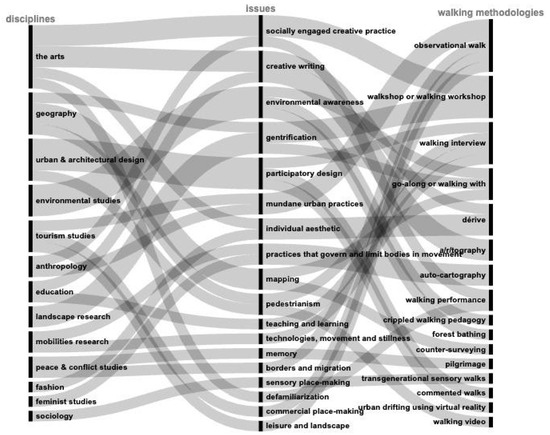
Figure 1.
Uses of walking methodologies to explore specific issues by diverse disciplines.
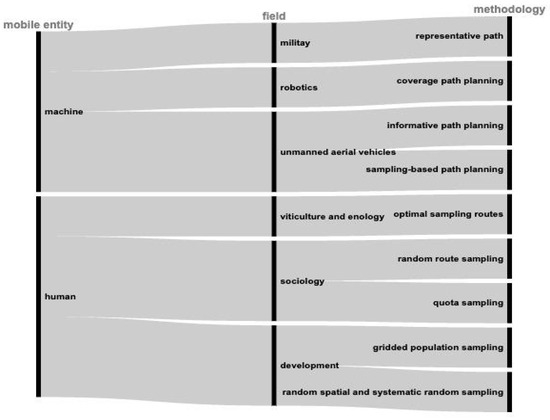
Figure 2.
Routing methodologies by different disciplines according to human/machine mobile entity.
2.1. Walking Methodologies
Observational walks entail a pedestrian route that includes some form of data collection, with different degrees of systematicity. This methodology is used by disciplines such as peace and conflict studies, and anthropology and tourism studies, to explore issues such as mundane urban practices, commercial placemaking, leisure, landscape, borders and migration. For instance, Duignan et al. [24] and Duignan and McGillivray [13] extensively apply observational walks to study uses of public spaces, street vending strategies, and the relation between local social fabrics and a global event such as the 2014 Rio Olympics. Similarly, Obradovic-Wochnik and Bird [25] dialogue with studies from anthropology that focus on objects and material cultures for tracing the daily life experience of migrants. In this case, the authors observe objects throughout the route over the Balkans that is followed by people migrating to the European Union.
Walkshops or walking workshops are a form of participatory research methodology that involves moving observation and collective creation. This methodology is used by disciplines such as anthropology, geography and landscape research. For instance, Leszczynski and Kong [11] use walking workshops to explore the role of bike-sharing infrastructure in the gentrification landscape of Toronto. Griffin [23], in turn, thoroughly discusses the process that led to the failure of a walkshop in Santiago de Chile during a moment of social turmoil in 2019. Conversely, although Lerman-Sinkoff et al. [26] do not explicitly use the term walkshop or walking workshop, their article on the ‘Become a Gas Leak Detective!’ programme in Massachusetts, fits the classification. Here, the authors use participant observation to explore the unfolding of a participatory walking pedagogy initiative led by teachers and environmental activists.
Walking interviews are like traditional interviews, but they occur while the interviewee is walking. This methodology can be found in works from fields such as education, geography, mobilities research and participatory design. In the fields of architecture and urban planning, authors such as Walshe et al. [16] and Andersen and Balbontin [27] explore the potential of walking interviews to generate inputs for the project design process. Similarly, Stratford et al. [28] employ walking interviews to understand the potential impacts of a pedestrian-oriented policy intervention in Wollongong, Australia.
Go-along, or walking-with, refers to a methodology that is mostly used by geography and environmental studies to move along mostly non-human phenomena such as built infrastructures, water courses and geological elements. One instance is the above-mentioned study on bike-sharing infrastructure and gentrification in Toronto by Leszczynski and Kong [11] which includes several walking methodologies but is modulated by the presence of bike-sharing stations. The study by Leszczynski and Kong, as well as others such as Motala and Bozalek [10] on Cape Town, associate go-alongs with diverse forms of mapping. Moreover, in an example of walking with both human and non-human actors, the study on movements in and out of a floodplain during the rainy season in central Mozambique by Arnall [9] uses walks to approach both farmers and topographic elements.
The dérive, or drift, involves random walks to explore and experience landscape, and is present in research from the arts and fashion design. Despite its former relevance in the social sciences and humanities, the drift is not significantly present in contemporary research from these fields. The reason is that the underlying assumptions behind randomness are an object of strong criticism when contributions from feminist theories are considered [29,30,31]. For instance, it can be argued that total randomness is never possible for female researchers, considering that sexual harassment in public spaces is widespread across geographies and cultures, at least during certain moments of the day and in some areas of a city: awareness regarding these risks is, thus, something that makes the female walker carefully consider her steps, which is the opposite to random drifting. Yet, scholars who work on creative practices such as Handcock and Joannides [32] on fashion and other forms of art, and Lasczik Cutcher and Irwin [33] on ‘slow scholarship’ and ‘A/r/tographic Peripatetic Inquiry’ still use ‘random’ drifting as a valid methodology.
A/r/tography is a mixture of art, research and geography, often used as a pedagogical tool for groups engaging with specific territories and their personal emotional and creative processes. A/r/tography usually involves a mixture of artistic expressions with a free range of walking methodologies. When using this methodology, a/r/tographers can facilitate collective learning experiences [34], gather objects and create new ones through compositions organically originated during walks [35], and to reflect on the a/r/tographic process itself [33].
Auto-cartography uses walking as a tool to explore constructions within the self that are associated to a gendered experience of the city, particularly in relation to practices that govern and limit bodies in movement [12]. Ng-Chan [36] proposes the concept of auto-cartography to explain the methodology behind her approach to what she calls ‘marginal walking’. In this case, the explored issue is the experience of racism in public spaces. This methodology emphasises ‘a phenomenological approach to the layers of autobiography and social relations, to understand how the self is co-constructed in relation to space and place’ [36] (p. 222). Similar issues are explored using a mixture of walking methodologies in the work on the experience of 11-year-old girls in public spaces by Horgan et al. [37]. Although the latter is not named as auto-cartography, it has many elements in common with the work by Ng-Chan.
Walking performance refers to moving performances that use walks as devices for interacting with things, places and/or audiences. For instance, Springgay and Truman [29] reflect on a sonic performance entitled ‘Walking to the Laundromat’, which uses sound, place and walking to explore bodily, affective and gendered labour. Similarly, Taylor et al. [38] developed a project entitled ‘Get Up and Move!’ which uses ‘walking as a methodology to envisage research in higher education beyond the human and outside individual, instrumental and competitive codings’ [38] (p. 13). These authors propose the notion of ‘concept-ing’ to conceptually explore walking as a ‘gift’.
Crippled or cripped walking pedagogy refers to the incorporation of a disabled walk into the experience of movement of those who can use their legs ‘normally’, inserting a different flow and timeline to the bodily experience of space. A conceptual development of this pedagogy, and of its theoretical implications, can be found in the work by Ware [39], providing a tool to develop research with a disability justice lens (as highlighted by Springgay and Truman [14]).
Forest bathing refers to the traditional act of walking in the woods and spending time in the forest. It is also developed by Ware [39] in his work that aims to generate pedagogical experiences with youths among Black persons and persons of colour. Forest bathing embraces simple and traditional practices, yet with strong potential for pedagogical exercises related to environmental awareness and health.
Counter-surveying is a methodology that uses walk to contrast maps of the current reality with extinct phenomena. It helps as a pedagogical tool to connect the present to the past, visiting places where buildings, people or events used to exist. Counter-surveying is proposed by Motala and Bozalek [10] to explore memories of apartheid in Cape Town, South Africa. As they discuss their experience inviting students from geomatics to perform ‘walking-as-research’, these authors ‘walk into the past and diffractively read the walks together with South African history, geomatics education, and posthumanist theory’ while, ‘premised on relational ontologies, (…) attend to the ghosts (…) and explore different ways of interrogating issues of land and education, while opening up a space for Otherness’ [10] (p. 244).
Pilgrimage refers to the ancient act of walking towards a site of worship or commemoration to demonstrate devotion. Bailey and Kingston [40] use pilgrimage as a mode of place-based inquiry, returning repeatedly to the Oklahoma City bombing memorial site that commemorates a terrorist attack that killed 168 people in 1995. These authors use the findings from this methodology to generate insights for peace education. Furthermore, Macpherson [41] discusses the works of other authors on the pilgrims in the Road to Santiago, in Spain. The continuous existence of sites of pilgrimage, and people practising pilgrimage, have been used to explore how long walks and even self-inflicted pain have an effect in generating experiences that change the minds of the walkers.
Transgenerational sensory walks involve people from different ages and pay attention to the comparison of their experiences. Murray and Järviluoma [30] use this methodology to explore cultural shifts in transgenerational perceptions between 1950 and 2020 in three national contexts—Turku (Finland), Brighton (United Kingdom) and Ljubljana (Slovenia). These authors investigate changes and multisensory engagements with local landscapes through a series of walks involving a younger person (often a child) and an older person.
Commented walks or parcours commenté are tools for participatory design that involve designers collectively experiencing a route with users, describing the space as it is toured. Andersen and Balbontin [27] propose using this methodology to generate inputs for designing a master plan in a university campus in Chile. The already mentioned walk by Walshe et al. [16] could also be included here, as they do walk interviews that focus on users and are oriented towards generating inputs for a potential space redesign.
Urban drifting using virtual reality involves the visual experience of a space that is computer generated or re-created and can allow people to anticipate what a potential reality can look like or to observe and tour places without being physically present. Salerno [15] mentions this methodology as one of the ways recent technologies are utilised to represent urban walks and explore reality, senses and imagination.
Walking video involves audiovisual recordings of one’s experience while waking, or that of someone who the observer is accompanying. Although video recordings are useful aids to support many other WMs, such as walk interviews, visual anthropologists propose walking videos as a methodology by itself and not as a mere auxiliary tool. As Pink [42] (p. 240) explains it, walking videos can be a ‘catalyst for creating ethnographic understandings of other people’s experiences, and representing these experiences to a wider audience’. The recent integration of digital tools has allowed mixtures between this methodology and GPS, as in the case of geotagged video capture by Duignan and McGillivray [13]. Walking videos have been useful for research in the fields of visual anthropology [42], geography [27] and tourism studies [13].
2.2. Informative Routing Optimization
The problem of route optimization to collect data can be named in many ways, such as representative path [43], coverage path [44], informative path [45], sampling-based path [46] and optimal sampling routes [47]. What they all have in common is the need to optimise routes to obtain samples from a subpopulation. As a result, we found nine routing and sampling methodologies, all summarised in Figure 2.
We found different methodologies depend on the nature of the mobile entity that obtains the samples. On the one hand, the case of human entities moving to collect data is almost entirely focused on face-to-face surveys that require household sampling [47,48,49,50]. An exception to the rule is associated with optimal sampling routes in the viticulture sector [46], where data are not a survey applied to humans but an assessment of the vines. On the other hand, cases of mobile entities that are machines, i.e., terrestrial and aerial robots, robotic arms, provide mixtures of route-planning algorithms for diverse types of data collection.
Interestingly, quantitative social sciences seem to rely on the idea of random walk as much as the criticised random drift from their qualitative relatives (see Section 2.1). Within sociology, Bauer [47,48] thoroughly discusses sampling bias when using the standard method among survey practitioners. This means random walk instructions for household selection when conducting face-to-face surveys with no complete list of respondents available. Like the criticisms of the undifferentiated practitioner of walking in the qualitative realm [30], Bauer claims that the supposedly random walk leads to sample bias.
Other authors depart from the random walk technique and add elements to overcome the issue of bias or lack of baseline data. For instance, Díaz de Rada and Martínez Martín [49] propose ‘quota sampling’, which involves instructions being used to select the ultimate respondents of face-to-face surveys according to quotas from a variable (i.e., gender, age) within households that are randomly drawn. Other examples propose techniques to help the collection of data in development interventions. Maduekwe and de Vries [51] recommend a ‘random spatial and systematic random sampling’ method. These authors use Geographical Information Systems (GISs) for random spatial sampling based on gridded population data, plus personal digital assistants (PDAs) with a GPS for household systematic random sampling with random walk.
There are also cases of the integration of algorithms into the routing and sampling process when it is performed by human entities. Chew et al. [50] suggest a ‘gridded population sampling’ technique, which entails a deep learning classification model, based on convolutional neural networks, to distinguish residential areas in satellite imagery, to then apply probability-based sampling on a gridded population, in contexts of a lack of baseline data. Moreover, the already mentioned ‘optimal sampling routes’ designed for viticulture by Oger et al. [52] involve an algorithm based on constraint programming and stochastic approaches to provide optimal sampling routes for vineyards, guaranteeing a representativeness of measurement sites and minimization of walking distance.
Path-planning algorithms for non-human entities have different scales. At a territorial scale, two cases were found. Banerjee and Chandrasekaran [43] discuss the application of artificial intelligence applied to the military domain. Specifically, these authors propose an algorithm that plans paths between regions in a bi-dimensional free space, based on a Voronoi diagram, and allows dynamic entity re-identification. Similarly, Darko et al. [46] focus on the problem of atmospheric measurement and unmanned aircraft systems. These scholars developed a path-planning algorithm for locating regions of a hurricane with highly uncertain prediction of measurements, also considering energy usage.
At smaller scales, examples are found in the field of robotics. Glorieux et al. [44] work on coverage path planning in the field of computer-integrated manufacturing. They generate a surface metrology system to inspect dimensional quality in robotic manufacturing, planning viewpoints in free-form surfaces, replacing random sampling with optimisation during the viewpoint sampling. Similarly, Schmid et al. [45] undertake informative path planning for micro aerial robotic vehicles. These authors deliver an online informative planning algorithm inspired by a rapidly exploring random tree (RRT), which continuously refines intermediate paths and ensures global coverage of an indoor space.
2.3. Enhancing Walking Methodologies with Machine Learning
At least two clear opportunities emerge after reviewing the literature on WMs and informative routing optimization. First, the use of ML points towards two clear functions that provide immediate improvements if adopted: routing and visual entity recognition. Second, it is possible to identify some WMs that are more suitable for adopting ML than others.
Different forms of routing emerge from Section 2.2. What is common among optimal routing in the cases of a vineyard, a free-formed manufactured surface, a small room and an entire city is that they involve spaces that can be accounted for by the displacement of an observer entity. Optimizing an exploratory, without pre-existent data, or inspective, with known problems and/or baseline data, route is something for which ML tools are well equipped. Moreover, examples such as vine quality, failures on surfaces, surface mapping or detection of contested elements involve visual inspection, which is something that can be automated by ML using deep learning models for visual recognition.
The WMs that are more suitable for adopting ML can be defined both in terms of opportunities and limitations. On the opportunity side, there are three clear examples: further development of the existent technologies, problem solving and quantitative complement to qualitative accounts. Walking videos [13,27,42] are the most obvious cases in which adding ML, for instance, through visual entity recognition, could add value from processing data that are already being collected. Examples such as Duignan and McGillivray [13], who already adopt digital videos mixed with geotagged images, provide cases where ML techniques would naturally fit within digital practices that are already in place. Problem solving supposes that introducing ML can provide a solution to some sort of challenge or difficulty involved in the application of a WM. Two examples are the need to generate quantitative data when implementing rapid methodologies [16], and the difficult task of writing notes during go-alongs in difficult terrain [9]. Finally, even the most subjective oriented studies could benefit from complementing qualitative data with quantitative accounts, as can be the case with auto-cartography [36]. Having quantitative data from the ‘exterior’ while concentrating on the ‘interior’ of the self, without the need for paying attention to or losing focus on the subjective experience, could add new methodological possibilities.
On the limitation side, in turn, not all routes are susceptible to ex-ante planning, and ethical issues emerge when videos involve personal data and identities. As reviewed in Section 2.1, it is still possible to find WMs that somehow include randomness in routes. In those cases, having a machine defining a route could be incompatible with the aims that guide the adopted methods. Furthermore, data required to apply algorithms might be available for some contexts over others. Regarding ethical issues, although consent from identifiable individuals can be obtained in some cases, many modes of using video or photo collection, at the volume that is needed for training entity recognition models, might require written consents to an extent that is not easy to achieve. For instance, while working in public spaces, limiting the images that are captured, or adding an administrative procedure such as signing consent sheets, might derail the entire appeal of using a WM in the first place. Solutions such as blurring faces exist but might not solve the entirety of ethical and administrative challenges that most scholars usually face.
3. Data and Methods
3.1. Hypothesis
The literature review on WMs and informative routing optimization signals towards a gap in the integration of human WMs and ML. For instance, the case of the use of a deep learning classification model by Chew et al. [49] is applied to generate baseline data on residential areas but not to the routing or sampling processes themselves. In this context, we propose a two-way integration of machine learning into walking methodologies. First, we use k-means, an unsupervised learning algorithm [17], to sample public spaces that are then the basis for informative routes. The resulting routes are intended for an observational walk (see Section 2.1) based on typologies of public spaces, as will be explained below. Second, we use a deep learning model, YOLOv5 [53], to identify instances and produce GIS maps based on geotagged photographs. We apply our methodology to the case of the Municipality of Santiago, the capital district of Chile. The details for each component are developed further below.
We set the general objective of the methodology as mapping incivilities in public spaces using observational walks that integrate both human and machine observation. We particularly look at litter as a type of incivility that the literature associates to constraints for the use of public spaces [54]. Specifically, we integrate ML into both route planning and instance detection.
Based on this objective, we hypothesize that using an object detection deep learning model to identify instances based on geotagged images captured during observational walks can produce reliable georeferenced data on litter in public spaces.
3.2. Methodology
A grouping unsupervised learning algorithm was incorporated to generate clusters of public spaces to then configure informative paths that were viable for observational cyborg walks. The first step of the methodology was to use the k-means and elbow criterion method [55] to generate subpopulations of public spaces based on variables that the research team considers relevant for defining their predominant uses. Six variables are included: a socioeconomic index in the surrounding blocks, residential density in the surrounding blocks, a count of four types of land use confronting the public spaces (see map on the left in Figure 3), a count of near bus stops inside a 100 m radius from the centre of each street, a count of green spaces inside a 500 m radius from the centre of each street and the distance to the closest green space in the same area. As a result, five clusters are generated. Figure 3 illustrates the original data on the left, and the resulting five clusters (0 to 4) on the right.
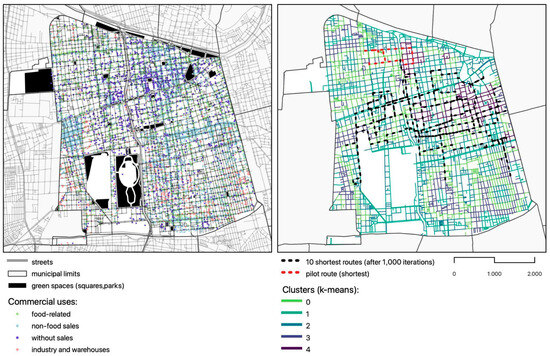
Figure 3.
Pre-clustering data, k-means results and 10 shortest route iterations.
The second step was to establish a procedure for generating one random point within each cluster, and then to define the shortest routes that covered the set of points, starting from cluster 0 and subsequently covering each until cluster 4. This procedure was applied using algorithms available on the QGIS 3.34.9 open-source software. In Algorithms 1–4, we provide the pseudocode [56] to allow others to replicate the same steps. This procedure was repeated a thousand times. Figure 4 shows the distribution of iterations ordered by the total length of each route generated. On the right side of Figure 3, only the ten shortest routes, after a thousand iterations, are drawn. As an example, Figure 5 illustrates the distribution of public space by cluster in the entire population alongside the first ten iterations.
| Algorithm 1 Randomised Points Sample Set Along Clustered Map Lines |
| 1: procedure RandomSampleSet(set size, sample size, points, map, clusters) 2: define set S 3: repeat 4: sample ← qgis.RandomPointsAlongLines(sample size, points, map, clusters) 5: S ←sample 6: until set size 7: return S 8: end procedure |
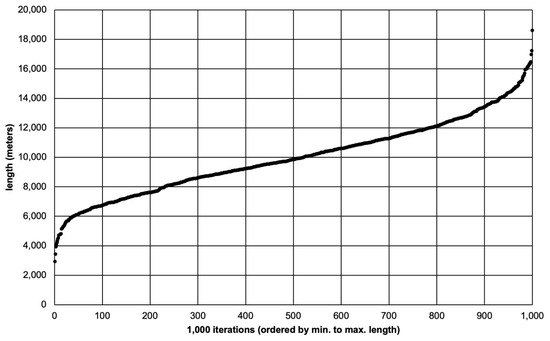
Figure 4.
Total route lengths after 1000 iterations.
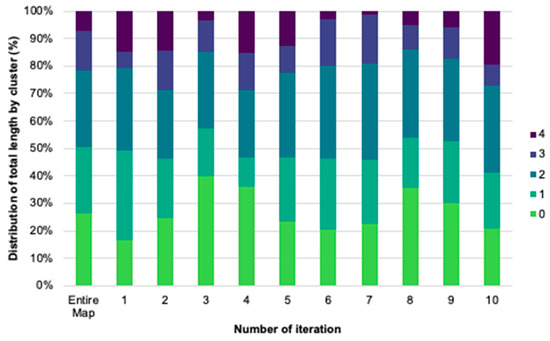
Figure 5.
Examples of distribution of total route length by cluster in 10 iterations.
| Algorithm 2 Distance Matrix Set from Randomised Points Sample Set |
| 1: procedure DistanceMatrixSet(sample set) 2: define set DMS 3: for each s ∈ sample set do 4: matrix ← qgis.DistanceMatrix(s) 5: DMS ← matrix 6: end for 7: return DMS 8: end procedure |
| Algorithm 3 Distance Filter Evaluation of Points Sample Set |
| 1: procedure EvaluateFilterDistance(sample set, dmatrix set) 2: define set of tuples EFD 3: for each (s, d) ∈ (sample set, dmatrix set) do 4: dist ← 0 5: for each p ∈ {s − last(s)} do 6: dist ← dist + qgis.proximity(p, p + 1) 7: end for 8: EFD ← (dist, s, d) 9: end for 10: return EFD 11: end procedure |
| Algorithm 4 Shortest Route Selection Algorithm |
| Require: map, a qgis map with identified streets. clusters, a qgis map with clustered streets. Ensure: route, an optimised randomly selected route. 1: samples ← RandomSampleSet(1000, 5, 1, map, clusters) 2: dmatrices ← DistanceMatrixSet(samples) 3: tuple ← EvaluateFilterDistance(samples, dmatrices) 4: smallest ← min(tuple) 5: msample ← unpack(smallest) 6: mccord ← qgis.geometry(msample) 7: route ← qgis.shortest path(mccord) 8: end procedure |
To empirically test the mixture of human and machine observation, we selected a route among the ten shortest ones after 1000 iterations. We evaluated the viability of routes, mixing the criterion of including all the clusters and presenting a walkable length. For the latter, we take in consideration the study by Sobková and Čertický [57], which defines 3.1 km as a normal daily walk length for a non-active adult, and 6.6 km for a physically active adult. Taking these values into consideration, we defined 5 kms as a threshold length for a viable observational walk.
A total of nine observers were recruited among undergraduate students in the university to which the researchers are affiliated. Observers walked in pairs, starting at 13:00 PM, equipped with an Insta360 X3 camera and an integrated GPS from the same camera manufacturer. The camera was fixed at the height of the shoulders of every observer. The camera was programmed to take a 170-degree-wide photograph every 3 s. The GPS reported the coordinates every time a photograph was taken. Every walk generated around 700 photos. Walks were repeated every weekday during the second week of January 2024.
In relation to the hypothesis, we aim to evaluate the accuracy of the YOLOv5 model for quantification based on visual observation from the cyborg walking method. We evaluate the ability to generate geotagged observations of litter, calculating the accuracy of the deep learning model compared to human observation. We used a pre-trained model for garbage detection to be run on the images taken in the walks. In addition, we manually tagged the images where the observers found garbage. We then compared both results to obtain an accuracy value, taking the total number of images showing litter according to the YOLOv5 model, and dividing it by the same count performed manually. We surveyed the existent literature on the use of the YOLOv5 model on litter detection as a benchmark to define the acceptable accuracy. Our results are, thus, compared to the accuracy obtained by the works by Zhang and He [58] and Titu et al. [59], which implemented similar experiments to ours using YOLOv5.
We also include the subjective evaluation of comfort by the humans performing the observational walk and discuss the results in light of the literature on WMs. A summary of the entire methodology can be found in Figure 6.
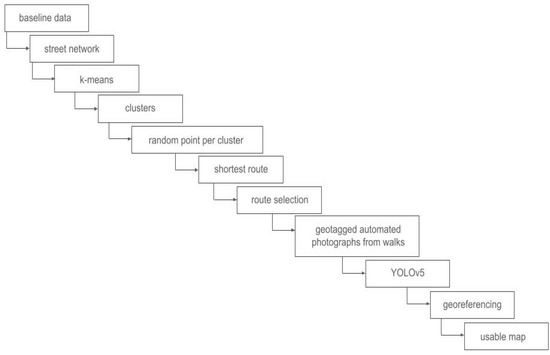
Figure 6.
Flow chart of the routing and data collection methodology.
3.3. Data
Data to run the k-means and elbow criterion method were obtained from different sources. The basis for georeferencing is a shape file of streets generated for the entire country by the Chilean National Institute of Statistics [60]. The socioeconomic index is the Social Material Territorial Index generated based on census data by the Observatory of Cities from the Catholic University of Chile [61]. Residential density was obtained using microdata from the 2017 census [62]. Land uses confronting the public spaces were surveyed by the research team in January 2023 as part of the preparation of the baseline for the current research, via observational walks performed by research assistants. Bus stops were available in the georeferenced data repository by the Centre for Sustainable Urban Development [63]. A cadastre of green spaces was available in the Open Data Centre of the Observatory of Cities from the Catholic University of Chile [64].
4. Results
After 1000 iterations, 14 routes, which means 1.4% of the total routes produced, were 5 km long or shorter. As exemplified in Figure 5 using the first ten iterations, although with variations in the distribution, all routes comply with including segments that correspond to each one of the five public space clusters. The use of the k-means and elbow criterion method successfully provided the basis for viable routes for observational walks performed by adult humans.
Yet, it is worth noting that a majority of 98.6% of routes were longer than 5 km, and 91.8% of the routes were longer than the 6.6 km threshold that the literature mentions for daily walking distances by physically active adults [57]. As can be observed in Figure 7, the distribution of lengths generated by groups of subsequent 100 iterations tends to be similar to the inverse S-shaped curve described by the 1000 iterations in Figure 4.
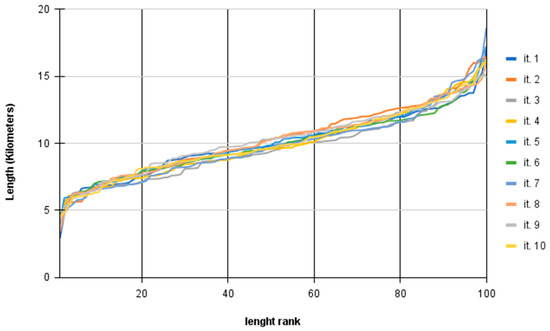
Figure 7.
Distribution of lengths among 100 iteration groups.
To test our hypothesis, a route was selected among the ten shortest ones. In this case, the path was picked because it had logistic advantages, which included that it was easily accessible from the university campus where the observers study. After some adjustments to accommodate a smooth departure and arrival using public transport, the final route had a length of 4 km. Among the nine observers who performed the observational walk, five were females and four males. Their ages ranged between 22 and 25. On average, the walks lasted one hour and twelve minutes.
In order to have valuable feedback for future route-planning processes, we generated a questionnaire for the observers, as summarised in Figure 8. In general, they tended to consider that the walks were comfortable. Eight of the observers rated overall comfort during the walk with a value of 4 in a Likert scale from 1 to 5, and one selected the maximum comfort. Only two of them noted significant differences in walking comfort along the route. When asked about specific factors, the presence of shadow and sidewalk conditions were the most mentioned as positively influencing walking comfort. The mention of shadows is linked to the fact that January is the middle of summer in Chile, with temperatures that can reach 36 degrees Celsius in the shade temperature. In contrast, the perception of insecurity, smells and pedestrian flow were considered phenomena that negatively affected walking comfort. It is worth noting that the research team previously defined walking in pairs as a way of reinforcing comfort and mitigating risks associated with crime or harassment.
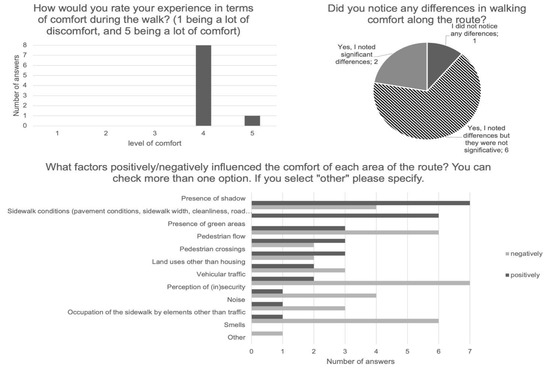
Figure 8.
Feedback by research assistants after implementing the pilot route (N = 9).
In relation to the reliability of data produced by the mixture of geotagged images and the YOLOv5 model, we tested the accuracy of the machine over humans counting litter in each photograph. The results were 92.6%, 95%, 87.9%, 88.5% and 83.7% for each working day, respectively, with an average of 89.54%. As mentioned, these results can be compared to those from similar experiments using a YOLOv5 model on litter detection. Accuracies reported in the literature were 86.93% [58] and 98% [59]. Consequently, accuracy from the cyborg walk experiment is similar to what is reported by similar experiments.
Furthermore, Figure 9 shows the kind of image that was captured by the camera, and how the deep learning model identified litter as an instance. Figure 10 shows how the results are geolocalised as dots in vectorial layers that can be handled by the QGIS software. The resulting dots in the map show the precise location of each photograph. Overall, we consider the experiment to be successful and the hypothesis to be accepted.
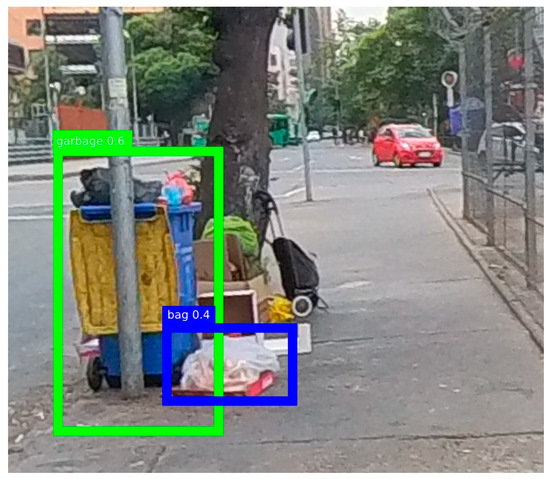
Figure 9.
Example of identification of litter using a pre-trained YOLOv5 model.
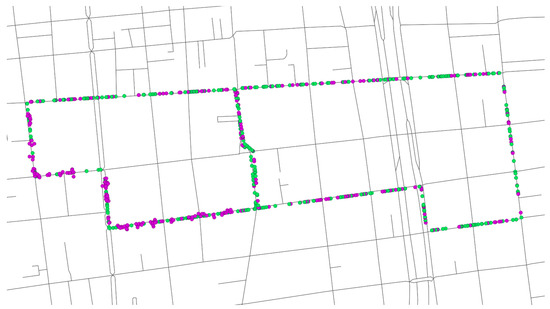
Figure 10.
Visualisation of geotagged images on the QGIS software. Dots are coloured according to results from identification by the YOLOv5 model (purple = litter, green = no litter).
5. Discussion
Although our hypothesis is accepted, a series of observations emerge from the process of defining routes and acknowledging the feedback from participants. The overarching issue is route lengths. When applied to the studied setting, most routes are not viable for all WMs, and particularly for those that involve participants who have difficulties covering long distances. Such a result leads to two reflections. On the one hand, the issue of the viability of routes should probably deserve more attention, including criteria that can allow a broader group of walking human bodies to participate. On the other hand, these results might be an opportunity for developing future algorithms, knowing that several routes can be discarded before subsequent steps that consume processing time and resources. Additionally, the factor of transport accessibility for researchers should be considered as a logistical element when developing an informative route optimisation algorithm.
As an illustration, studies have shown that children do not walk when the route exceeds 1500 m, and that girls are less likely to walk than boys [65]. This means our routes would be difficult for children and, eventually, to be even less suitable for girls. These challenges could be the basis for enriching WMs, following examples such as transgenerational walks [30]. Furthermore, according to a published systematic review on factors influencing walking [66], the elements mentioned by participants in our study resonate with the existing scholarship. For instance, in terms of safety, crime is a top concern, either with an emphasis on the person or personal property. In terms of comfort, a set of factors negatively influence the perception of potential walkers: noise and atmospheric pollution, lack of vegetation, poor lighting, bad weather conditions, slopes and long distances.
Additionally, the results discussed so far can inspire some links with the existing literature on WMs (Section 2.1). We consider that at least five points should be highlighted: the potential for rapid methodologies, the disposition of the walker, how the tested technologies affect physical, social and political corporalities, the potential integration with walking videos and go-alongs, and, finally, the links between our empirical approach to cyborg walk and Hathaway’s seminal metaphor of the cyborg.
5.1. Potential for Rapid Methodologies
Particularly after the COVID-19 pandemic, professions such as health workers and school teachers have experienced increasing exhaustion while at the same time becoming subjects of exacerbated scientific interest. Noting the ethical and practical considerations when researching these types of ‘busy people’, scholars that use WMs have highlighted the relevance of rapid methodologies such as free listing and walking interviews [16]. Moreover, other examples like the walks with farmers through floodplains in Mozambique by Arnall [9] point towards the practical difficulty for taking notes en route, and the need to quickly register data while details are still fresh in one’s memory. In relation to this need for quickness, a first discussion that our results can spark is the potential to add automated devices and ML to generate content while walking. At a time when ML-based note-takers are proliferating in academic and non-academic telematic meetings, adding equivalent tools to collect data while walking does not seem far off. The methodologies tested in our experiment can be useful as part of rapid methodologies that could enrich what is obtained from brief moments alongside busy people or through difficult terrain.
5.2. Potential Integration into Walking Videos and Go-Alongs
Walking videos and walking-with, or go-along, although they can be mentioned among rapid methodologies, deserve specific attention. On the one hand, some scholars who base their work on videos defend the idea that, beyond an auxiliary tool, videos and cinematic cartographies are themselves a valid form of experiencing walking [36,67]. When we add another layer to those videos, by introducing deep learning applied to the visuals, the audiovisual potential expands. Moreover, amid visual-dominated social sciences, scholars exploring performance remind us that sound is also a significant source of data, knowledge and expression [29]. Consequently, audio could be an object of analysis using deep learning models too. Furthermore, specific models such as YOLOv5 could be used in real time, opening up the potential for data-based rapid adaptation during routes, as has been developed in the field of robotics [44].
In addition to the audiovisual potential of our cyborg walking method, it can also expand quantitative data collection in multiple forms of walking-withs. For example, in the reviewed literature, researchers go along fresh water creeks [12], bike-sharing stations [11], farmers in and out of a floodplain [9] (p. 1), gas pipes [26], forests [29], migrant routes [25], former limits of apartheid segregation [10], street vendors [13,24] and neighbourhoods that will be the subject of a walkable city strategy by authorities [27]. In every case, cameras, sensors and other devices, paired with GPS and ML, could automatically generate layers of quantitative data that can expand the scope of a survey and foster mixed methodologies.
5.3. Disposition of the Walker
All of the latter must be considered in tandem with the ways in which the proposed devices and methods might alter the embodied dispositions of the walker [41]. As has been largely discussed by researchers of long walking traditions such as pilgrimage [40], walking can change the mind of the walker. Embodied dispositions interact with other features of the walk such as rhythm and style that have significant meanings within every specific cultural context and can alter data collection. For instance, we experienced the contrasting situations of, first, participants being more fearful of being robbed because of having the camera in a visible place on their bodies, and second, a student who took the automated camera along to a football match involving Colo Colo, the most popular team in Chile. On the one hand, the disposition of the walker might be one of increased self-awareness, but, on the other hand, people from some age segments, even in risky contexts like a football match in South America, might already be accustomed to wearing technological items to an extent that adding a camera might seem casual.
5.4. Physical, Social and Political Corporalities
The embodied disposition of the walker is embedded in power structures that constrain bodies in movement [12]. In other words, some bodies can walk more freely than others because of gender, recognised and unrecognised labour, different forms of violence, and other written and unwritten rules within the social order [29]. Such considerations can be pushed further while accounting for the discussion on risk to the researchers by Martinez and Gois [31]. These authors argue that the interaction between place, race and gender imposes limits on the knowledge produced by walking researchers. In our case, looking at the embeddedness of bodily dispositions in broader power relations, limits imposed by place, gender and race could apply both to the routes in the city and the university campuses from where the research team comes. For instance, the neighbourhoods where the route was performed have been increasingly racialised after a rise in Latin American and Caribbean migration into downtown Santiago [68]. Furthermore, our research is produced within the male-dominated space of Science, Technology, Engineering and Mathematics (STEM). Our own disposition towards adopting cyborg walking must include consciousness regarding the fact that these constraints, and particularly gender, affect the likelihood of specific scholars being able to bridge the qualitative and the quantitative traditions by integrating ML and WMs. And, of course, recruiting, methods, protocols and every aspect of our research praxis should include a critical perspective of our presence, and the presence of the machines we bring with us, in specific territories.
5.5. Cyborg Walk and Hathaway’s Cyborg
Finally, since we use the concept of cyborg walking in a context that includes dialogue with the social sciences, the humanities and the arts, it is necessary to acknowledge the seminal influence of Donna Haraway’s work in introducing the cyborg metaphor. In this regard, the question is whether our pragmatic hybridisation of machine and human in this experiment also has links with the mythical cyborg proposed by Haraway [18]. Our belief is that our cyborg walks share elements with Haraway’s cyborg manifesto in two dimensions. First, she criticises the use of strict disciplinary boundaries and rather focuses on points of intersection. In this regard, this research is multi- and transdisciplinary in its origin and results: the research team bridges computer science, urban planning and social sciences, the integration of topics, methods and literature is patent in Section 2 and Section 3, and we end up exploring common languages and mixed lenses within a transdisciplinary praxis. Second, as should be evident after reading the article, our research is clearly a part of efforts to collapse dualisms such as organism versus machine and physical versus non-physical, just as proposed by Haraway. Third, and finally, Haraway proposes the image of the cyborg as one that is useful for creating collective efforts for community and pleasure. We believe that focusing on conditions that enable the use and activation of public spaces entails a fundamental aim to contribute to liveable cities, where community and pleasure are central. All in all, the cyborg walk calls for integrating the cyborg and WMs both in practical and theoretical terms.
6. Conclusions
Walking methodologies and machine learning are being used separately by urban scholars to capture data and generate innovative analysis in cities. Yet, it is difficult to find integration between the two. We surveyed the literature on walking methodologies and distinguished between 16 types of specific methods. We also reviewed the literature from different fields on the problem of informative routing optimization, discussing algorithms used in robotics, unmanned vehicles and viticulture, all of which could be adopted by walking methodologies.
After identifying the gap regarding the integration between walking methodologies and machine learning, we designed and implemented an experiment to check the reliability of integrating machines into walking route definition and quantitative data collection. We call our method cyborg walking, and implemented it in an experiment in the centre of Santiago, the capital of Chile, quantifying litter in the streets.
We proposed a threshold of 5 km as a distance that is viable for an average walking researcher and combined a set of algorithms with the k-means unsupervised learning method to define public space typologies that had to be covered by the routes. After 1000 iterations of our algorithms, 1.4% of routes were 5 km long or shorter. On the other hand, we successfully generated maps in a Geographical Information Systems format, based on automatic geotagged photography, and a deep learning YOLOv5 model for image recognition, which performed with an accuracy between 83.7% and 95% compared to entirely human data collection.
The combination of our results with the review of the literature on walking methodologies suggests that introducing machine learning presents significant potential for walking scholars. We consider that our cyborg walking resonates with the aims of many walking methodologies, and with the critiques on the boundaries between organism versus machine and physical versus digital, posed by the original Cyborg Manifesto by Donna Haraway. We proved that informative route optimisation and visual data collection can be immediately impacted by introducing specific machine learning models. We hope this bridge of human walking and machines can spark innovative approaches among urban scholars and researchers from other disciplines.
Author Contributions
Conceptualization, N.V.-L., N.G.R., C.N., W.K. and N.T.; methodology, N.V.-L., N.G.R. and C.N.; software, C.N. and N.T.; validation, N.G.R., W.K. and M.Z.; formal analysis, N.V.-L. and C.N.; investigation, N.V.-L., N.G.R., C.N. and J.P.-M.; resources, N.V.-L. and N.G.R.; data curation, N.V.-L., C.N. and J.P.-M.; writing—original draft preparation, N.V.-L.; writing—review and editing, N.G.R. and W.K.; visualization, N.V.-L., N.G.R., C.N. and J.P.-M.; supervision, W.K. and N.T.; project administration, N.V.-L. and J.P.-M.; funding acquisition, N.V.-L. and N.G.R. All authors have read and agreed to the published version of the manuscript.
Funding
The authors gratefully acknowledge the research support provided by CEDEUS, ANID/FONDAP 1522A0002 and ANID Fondecyt Iniciación 11221325.
Data Availability Statement
The dataset is available on request from the authors.
Conflicts of Interest
The authors declare no conflicts of interest.
References
- Arias, D. Etnografía en movimiento para explorar trayectorias de niños y jóvenes en Barcelona. Rev. Antropol. Soc. 2017, 26, 93–102. [Google Scholar] [CrossRef]
- Augoyard, J. Pas à pas Essai sur le Cheminement en Milieu Urbain, 2nd ed.; A la Croisée: Tours, France, 1970; ISBN 2020051702. [Google Scholar]
- de Certeau, M.; Giard, L.; Mayol, P. L’invention du Quotidien; Éditions Gallimard: Paris, France, 1984; ISBN 2-296-00906-9. [Google Scholar]
- Sansot, P. La poétique de la ville; Armand Colin: Paris, France, 1996; ISBN 978-2-228-89894-2. [Google Scholar]
- Joseph, I. Retomar la Ciudad: El Espacio Público Como Lugar de Acción; Universidad Nacional de Colombia: Medellín, Colombia, 1998; ISBN 9789586961370. [Google Scholar]
- Petiteau, J.; Pasquier, E. La méthode des itinéraires: Récits et parcours. In L’espace Urbain en Méthodes; Grosjean, M., Thibaud, J.-P., Eds.; Ed. Parenthèses: Marseille, France, 2001; pp. 63–78. ISBN 2-86364-624-9. [Google Scholar]
- Delgado, M. El Animal Público; Anagrama: Barcelona, España, 1999; ISBN 978-84-339-0580-2. [Google Scholar]
- Careri, F. Walkscapes. El Andar Como Práctica Estética; Gustavo Gili: Barcelona, Spain, 2002; ISBN 978-84-252-1841-5. [Google Scholar]
- Arnall, A. Walking with farmers: Floods, agriculture and the social practice of everyday mobility. Glob. Environ. Chang. 2021, 69, 102289. [Google Scholar] [CrossRef]
- Motala, S.; Bozalek, V. Haunted walks of District Six: Propositions for counter-surveying. Qual. Inq. 2022, 28, 244–256. [Google Scholar] [CrossRef]
- Leszczynski, A.; Kong, V. Walking (with) the platform: Bikesharing and the aesthetics of gentrification in Vancouver. Urban Geogr. 2023, 44, 773–795. [Google Scholar] [CrossRef]
- Springgay, S.; Truman, S.E. Walking Methodologies in a More-than-Human World: WalkingLab; Routledge: London, UK, 2017; ISBN 9780367264956. [Google Scholar]
- Duignan, M.; McGillivray, D. Walking methodologies, digital platforms and the interrogation of Olympic spaces: The ‘# RioZones-Approach’. Leis. Stud. 2019, 38, 184–196. [Google Scholar] [CrossRef]
- Springgay, S.; Truman, S.E. Critical walking methodologies and oblique agitations of place. Qual. Inq. 2022, 28, 171–176. [Google Scholar] [CrossRef] [PubMed]
- Salerno, R. From “la Dérive” to Virtual Reality: Representing the Urban Walk Between Reality, Senses and Imagination. In Experiential Walks for Urban Design: Revealing, Representing, and Activating the Sensory Environment; Urban Books: New York, NY, USA, 2021; pp. 163–174. ISBN 978-3-030-76694-8. [Google Scholar]
- Walshe, R.; Law, L. Doing research with busy people: Enacting rapid walking methodologies with teachers in a primary school. Cities 2024, 145, 104707. [Google Scholar] [CrossRef]
- Wang, J.; Biljecki, F. Unsupervised machine learning in urban studies: A systematic review of applications. Cities 2022, 129, 103925. [Google Scholar] [CrossRef]
- Haraway, D. A cyborg manifesto: Science, technology, and socialist-feminism in the late twentieth century. In The Transgender Studies Reader; Routledge: New York, NY, USA, 2013; pp. 103–118. ISBN 9781912453115. [Google Scholar]
- Sankai, Y. HAL: Hybrid assistive limb based on cybernics. In Robotics Research: The 13th International Symposium ISRR; Springer: Berlin/Heidelberg, Germany, 2011; pp. 25–34. [Google Scholar]
- Chu, Z.; Gianvecchio, S.; Wang, H.; Jajodia, S. Who is Tweeting on Twitter: Human, Bot, or Cyborg? In Proceedings of the 26th Annual Computer Security Applications Conference, Austin, TX, USA, 6–10 December 2010; pp. 21–30. [Google Scholar]
- Mannoor, M.S.; Jiang, Z.; James, T.; Kong, Y.L.; Malatesta, K.A.; Soboyejo, W.O.; McAlpine, M.C. 3D printed bionic ears. Nano Lett. 2013, 13, 2634–2639. [Google Scholar] [CrossRef] [PubMed]
- Zuniga, J.; Katsavelis, D.; Peck, J.; Stollberg, J.; Petrykowski, M.; Carson, A.; Fernandez, C. Cyborg beast: A low-cost 3d-printed prosthetic hand for children with upper-limb differences. BMC Res. Notes 2015, 8, 10. [Google Scholar] [CrossRef]
- Griffin, G. When method fails: Walking as an alt-meth in a volatile context. Qual. Res. J. 2021, 21, 40–50. [Google Scholar] [CrossRef]
- Duignan, M.B.; Down, S.; O’Brien, D. Entrepreneurial leveraging in liminoidal Olympic transit zones. Ann. Tour. Res. 2020, 80, 102774. [Google Scholar] [CrossRef]
- Obradovic-Wochnik, J.; Bird, G. The everyday at the border: Examining visual, material and spatial intersections of international politics along the ‘Balkan Route’. Coop. Confl. 2020, 55, 41–65. [Google Scholar] [CrossRef]
- Lerman-Sinkoff, S.; Wylie, S.; Jalbert, K.; Moore, G.; Rogan, J. “Become a Gas Leak Detective!” Evaluating a multigenerational citizen science program for connecting distribution pipelines to energy justice. Energy Res. Soc. Sci. 2023, 105, 103251. [Google Scholar] [CrossRef]
- Andersen, K.; Balbontin, S.A. Walking Methodology as the Participatory Tool for a University Master Plan Design. In Experiential Walks for Urban Design: Revealing, Representing and Activating the Sensory Environment; Springer: Berlin/Heidelberg, Germany, 2021; pp. 289–301. [Google Scholar] [CrossRef]
- Stratford, E.; Waitt, G.; Harada, T. A relational approach to walking: Methodology, metalanguage, and power relations. Geogr. Res. 2021, 59, 91–105. [Google Scholar] [CrossRef]
- Springgay, S.; Truman, S.E. A transmaterial approach to walking methodologies: Embodiment, affect, and a sonic art performance. Body Soc. 2017, 23, 27–58. [Google Scholar] [CrossRef]
- Murray, L.; Järviluoma, H. Walking as transgenerational methodology. Qual. Res. 2020, 20, 229–238. [Google Scholar] [CrossRef]
- Martinez, C.A.F.; Gois, G.R. Walking as Political Utterance: The Walking Subjects and the Production of Space. Qual. Inq. 2022, 28, 209–218. [Google Scholar] [CrossRef]
- Handcock, T.; Joannides, T. Urban Flâneur: A Site-Responsive Walking Methodology for Fashion Design. In Experiential Walks for Urban Design: Revealing, Representing, and Activating the Sensory Environment; Urban Books: New York, NY, USA, 2021; pp. 275–288. ISBN 978-3-030-76694-8. [Google Scholar]
- Lasczik Cutcher, A.; Irwin, R.L. A/r/tographic Peripatetic Inquiry and the Flâneur. In The Flâneur and Education Research: A Metaphor for Knowing, Being Ethical and New Data Production; Irwin, R.L., Sinner, A., Adams, J., Eds.; Springer: Cham, Switzerland, 2018; pp. 127–154. ISBN 978-3-319-72838-4. [Google Scholar]
- Lee, N.; Morimoto, K.; Mosavarzadeh, M.; Irwin, R.L. Walking propositions: Coming to know a/r/tographically. Int. J. Art Des. Educ. 2019, 38, 681–690. [Google Scholar] [CrossRef]
- Barney, D.T. A/r/tography as a pedagogical strategy: Entering somewhere in the middle of becoming artist. Int. J. Art Des. Educ. 2019, 38, 618–626. [Google Scholar] [CrossRef]
- Ng-Chan, T. Marginal walking. Qual. Inq. 2022, 28, 219–227. [Google Scholar] [CrossRef]
- Horgan, D.; Fernández, E.; Kitching, K. Walking and talking with girls in their urban environments: A methodological meandering. Ir. J. Sociol. 2023, 31, 101–124. [Google Scholar] [CrossRef]
- Taylor, C.A.; Hogarth, H.; Cranham, J.; Hewlett, S.J.; Bastos, E.; Barratt Hacking, E.; Barr, K. Concept-ing with the gift: Walking method/ologies in posthumanist research. J. Posthumanism 2023, 3, 13–31. [Google Scholar] [CrossRef]
- Ware, S.M. Foraging the future: Forest baths, engaged pedagogy, and planting ourselves into the future. Qual. Inq. 2022, 28, 236–243. [Google Scholar] [CrossRef]
- Bailey, L.E.; Kingston, A.M. Pilgrimage as a mode of inquiry: The Oklahoma City bombing memorial as entangled place of education. J. Peace Educ. 2020, 17, 283–307. [Google Scholar] [CrossRef]
- Macpherson, H. Walking methods in landscape research: Moving bodies, spaces of disclosure and rapport. Landsc. Res. 2016, 41, 425–432. [Google Scholar] [CrossRef]
- Pink, S. Walking with video. Vis. Stud. 2007, 22, 240–252. [Google Scholar] [CrossRef]
- Banerjee, B.; Chandrasekaran, B. A framework of voronoi diagram for planning multiple paths in free space. J. Exp. Theor. Artif. Intell. 2013, 25, 457–475. [Google Scholar] [CrossRef]
- Glorieux, E.; Franciosa, P.; Ceglarek, D. Coverage path planning with targetted viewpoint sampling for robotic free-form surface inspection. Robot. Comput.-Integr. Manuf. 2020, 61, 101843. [Google Scholar] [CrossRef]
- Schmid, L.; Pantic, M.; Khanna, R.; Ott, L.; Siegwart, R.; Nieto, J. An efficient sampling-based method for online informative path planning in unknown environments. IEEE Robot. Autom. Lett. 2020, 5, 1500–1507. [Google Scholar] [CrossRef]
- Darko, J.; Folsom, L.; Park, H.; Minamide, M.; Ono, M.; Su, H. A sampling-based path planning algorithm for improving observations in tropical cyclones. Earth Space Sci. 2022, 9, e2020EA001498. [Google Scholar] [CrossRef]
- Bauer, J.J. Selection errors of random route samples. Sociol. Methods Res. 2014, 43, 519–544. [Google Scholar] [CrossRef]
- Bauer, J.J. Biases in random route surveys. J. Surv. Stat. Methodol. 2016, 4, 263–287. [Google Scholar] [CrossRef]
- Díaz de Rada, V.; Martín, V.M. Random route and quota sampling: Do they offer any advantage over probability sampling methods? Open J. Stat. 2014, 4, 391–401. [Google Scholar] [CrossRef]
- Chew, R.F.; Amer, S.; Jones, K.; Unangst, J.; Cajka, J.; Allpress, J.; Bruhn, M. Residential scene classification for gridded population sampling in developing countries using deep convolutional neural networks on satellite imagery. Int. J. Health Geogr. 2018, 17, 12. [Google Scholar] [CrossRef]
- Maduekwe, E.; de Vries, W.T. Random spatial and systematic random sampling approach to development survey data: Evidence from field application in Malawi. Sustainability 2019, 11, 6899. [Google Scholar] [CrossRef]
- Oger, B.; Laurent, C.; Vismara, P.; Tisseyre, B. Is the optimal strategy to decide on sampling route always the same from field to field using the same sampling method to estimate yield? OENO One 2021, 55, 133–144. [Google Scholar] [CrossRef]
- Tang, Y.; Zhou, H.; Wang, H.; Zhang, Y. Fruit detection and positioning technology for a Camellia oleifera C. Abel orchard based on improved YOLOv4-tiny model and binocular stereo vision. Expert Syst. Appl. 2023, 211, 118573. [Google Scholar] [CrossRef]
- Dawson, L.; Elbakidze, M.; van Ermel, L.K.; Olsson, U.; Ongena, Y.P.; Schaffer, C.; Johansson, K.E. Why don’t we go outside? Perceived constraints for users of urban greenspace in Sweden. Urban For. Urban Green. 2023, 82, 127865. [Google Scholar] [CrossRef]
- Syakur, M.A.; Khotimah, B.K.; Rochman, E.M.S.; Satoto, B.D. Integration k-means clustering method and elbow method for identification of the best customer profile cluster. In Proceedings of the IOP Conference Series: Materials Science and Engineering, Surabaya, Indonesia, 9 November 2017; Volume 336, p. 012017. [Google Scholar]
- Singh, A.K.; Krishnan, S. ECG signal feature extraction trends in methods and applications. Biomed. Eng. Online 2023, 22, 22. [Google Scholar] [CrossRef]
- Sobková, L.F.; Čertický, M. Urban mobility and influence factors: A case study of Prague. WIT Trans. Built Environ. 2017, 176, 207–217. [Google Scholar] [CrossRef]
- Zhang, Q.; He, H. Research of an Enhanced YOLOv5-Based Algorithm for Garbage Detection in Service Areas. In Proceedings of the 2024 4th International Conference on Neural Networks, Information and Communication (NNICE), Guangzhou, China, 19–21 January 2024; pp. 889–894. [Google Scholar]
- Titu, M.F.S.; Chowdhury, A.A.; Haque, S.R.; Khan, R. Deep-Learning-Based Real-Time Visual Pollution Detection in Urban and Textile Environments. Science 2024, 6, 5. [Google Scholar] [CrossRef]
- Instituto Nacional de Estadísticas. Geodatos Abiertos. Available online: https://www.ine.gob.cl/docs/default-source/geodatos-abiertos/cartografia/censo-2017/capas-base/capas_base_r13.rar?sfvrsn=7e719093_3&download=true (accessed on 27 May 2024).
- Observatorio de Ciudades UC. Índice Socio Material y Territorial (ACTUALIZACIÓN METODOLÓGICA 2022—DATOS CENSO 2017). Available online: https://ideocuc-ocuc.hub.arcgis.com/maps/c83a1ea2c31b4850b65a481b21e4919f/about (accessed on 27 May 2024).
- Instituto Nacional de Estadísticas. Microdatos Censo Urbano. Available online: https://www.ine.gob.cl/docs/default-source/geodatos-abiertos/cartografia/censo-2017/siedu/shp/microdatos_manzana.zip?sfvrsn=972b0c54_3 (accessed on 27 May 2024).
- Centro de Desarrollo Urbano Sustentable. Paraderos del Transantiago. Available online: http://datos.cedeus.cl/layers/geonode:santiago_gtfs_stops_sept2014 (accessed on 27 May 2024).
- Observatorio de Ciudades UC. Estado Áreas Verdes Santiago. Available online: https://ideocuc-ocuc.hub.arcgis.com/datasets/1ae5e0b957124176844f48b935fa8d2f/explore (accessed on 27 May 2024).
- Ermagun, A.; Samimi, A.; Rashidi, T.H. How far is too far? Providing safe and comfortable walking environments. Transp. Res. Rec. 2016, 2586, 72–82. [Google Scholar] [CrossRef]
- Ferreira, M.C.; Costa, P.D.; Abrantes, D.; Hora, J.; Felício, S.; Coimbra, M.; Dias, T.G. Identifying the determinants and understanding their effect on the perception of safety, security, and comfort by pedestrians and cyclists: A systematic review. Transp. Res. Part F Traffic Psychol. Behav. 2022, 91, 136–163. [Google Scholar] [CrossRef]
- Ng-Chan, T. Mapping out patience: Cartography, cinema and W.G. Sebald. Humanities 2015, 4, 554–568. [Google Scholar] [CrossRef]
- Sheehan, M. Everyday verticality: Migrant experiences of high-rise living in Santiago, Chile. Urban Stud. 2022, 59, 00420980221114206. [Google Scholar] [CrossRef]
Disclaimer/Publisher’s Note: The statements, opinions and data contained in all publications are solely those of the individual author(s) and contributor(s) and not of MDPI and/or the editor(s). MDPI and/or the editor(s) disclaim responsibility for any injury to people or property resulting from any ideas, methods, instructions or products referred to in the content. |
© 2024 by the authors. Licensee MDPI, Basel, Switzerland. This article is an open access article distributed under the terms and conditions of the Creative Commons Attribution (CC BY) license (https://creativecommons.org/licenses/by/4.0/).